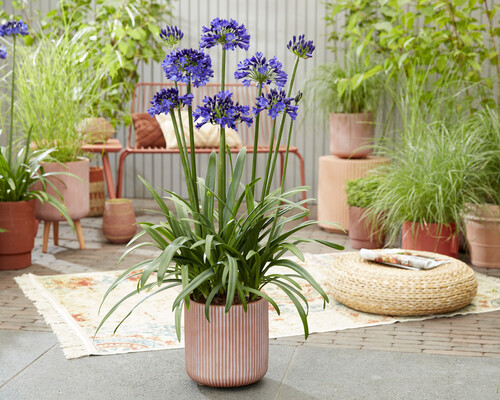Agapanthus Expanding Problems: Soil, Sunshine, and Watering
Agapanthus Expanding Problems: Soil, Sunshine, and Watering
Blog Article
Mastering the Art of Agapanthus Care: Necessary Steps for Healthy Growth and Dynamic Blooms
In the world of cultivation, the cultivation of agapanthus stands as a satisfying endeavor for those that seek to nurture these classy blooming plants. From selecting the ideal selection to mastering trimming techniques, the trip in the direction of cultivating flourishing agapanthus plants is multifaceted and holds the vital to opening the complete capacity of these herb treasures.
:max_bytes(150000):strip_icc()/agapanthus-growing-guide-7368912_04-66a3f4cf245b4332b28954dd37c784f5.jpg)
Choosing the Right Agapanthus Selection

When picking the appropriate Agapanthus range for your garden, consider elements such as climate suitability, bloom color, and development routine. Additionally, take into consideration the climate in your area to make sure the Agapanthus variety you select can flourish in your specific problems. Understanding the development practice of different Agapanthus selections is critical for proper positioning within your yard.
Ideal Growing Conditions
Considering the ideal environmental needs is necessary for effective Agapanthus cultivation. Agapanthus plants are delicate to chilly temperatures and must be shielded from frost during wintertime months.
To make sure healthy growth and dynamic blooms, plant Agapanthus bulbs at a depth of about 2-4 inches and area them 8-12 inches apart. Mulching around the base of the plants aids retain moisture and subdues weed development.
Watering and Fertilizing Tips
Maintaining correct moisture levels and providing important nutrients are key components in the treatment program for Agapanthus plants. When it pertains to watering Agapanthus, it is critical to strike an equilibrium. If overwatered, these plants favor regularly wet dirt but are prone to root rot. During the expanding season, water deeply when a week, making certain the soil is well-draining to stop waterlogging. In hotter climates or throughout periods of drought, even more constant watering may be required to keep the dirt uniformly moist. Nonetheless, decrease watering in the winter to stop water logged conditions.
Fertilizing Agapanthus is essential for advertising healthy growth and prolific blooms. Apply a well balanced plant food, such as a 10-10-10 formula, in the very early spring as brand-new growth emerges. Repeat this application every 6-8 weeks throughout the growing period. Avoid excessive fertilization, as it can lead to lavish vegetation at the cost of blooms. Constantly adhere to the supplier's guidelines for proper dilution and application methods. By following these watering and fertilizing suggestions, you can ensure your Agapanthus plants prosper and produce lively, durable flowers.
Pruning Methods for Agapanthus
Trimming Agapanthus plants at the appropriate times and with correct strategies is critical for keeping their health and wellness and promoting optimum growth and blooming. The suitable time to trim Agapanthus is in late winter or very early spring before new development emerges.
Deadheading spent blossoms can likewise reroute the plant's power right into creating even more blooms instead than establishing seeds. great post to read If you want to accumulate seeds for breeding, leave some flowers to fully grown and dry on the plant.
Remember to use clean, sharp tools to make precise cuts and lower the danger of presenting illness. Agapanthus. Regular trimming will assist maintain your Agapanthus looking neat and healthy and balanced while guaranteeing a plentiful display screen of lovely blooms
Handling Common Bugs and Diseases
After guaranteeing appropriate trimming methods for Agapanthus, it is crucial to attend to typical bugs and conditions that can influence the wellness and vigor of these plants. One typical pest that affects Agapanthus is the Agapanthus gall midget.
An additional usual concern is fungal fallen leave place, which presents as dark lesions on the leaves. To prevent fungal illness, make sure excellent air blood circulation around the plants, prevent overhead watering, and remove any contaminated leaves promptly. Furthermore, Agapanthus plants can struggle with root rot if they are planted in badly draining pipes soil. To avoid this, plant Agapanthus in well-draining soil and avoid overwatering. By being alert and taking timely action against bugs and conditions, you can assist your Agapanthus plants flourish and create dynamic blooms.

Conclusion
In verdict, mastering the art of agapanthus care entails selecting the best range, supplying ideal planting conditions, appropriate watering and feeding, proper pruning methods, and attending to common pests and diseases. By complying go with these important steps, you can make certain healthy growth and lively blooms for your agapanthus plants. Keep in mind to consistently keep track of and preserve your plants to promote their general wellness and long life.
To make sure healthy growth and vibrant blooms, plant Agapanthus light bulbs at a depth of regarding 2-4 inches and area them 8-12 inches apart. By complying with these watering and fertilizing ideas, you can guarantee your Agapanthus plants prosper and generate vivid, long-lasting blooms.
One typical bug that influences Agapanthus is the Agapanthus gall midget. In addition, Agapanthus plants can suffer Visit Your URL from root rot if they are grown in badly draining dirt. By adhering to these vital actions, you can make certain healthy growth and vibrant blossoms for your agapanthus plants.
Report this page